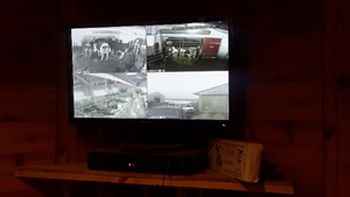Schanbacher farm
Atkins, Iowa

The Schanbachers (father, mother and son) keep 107 milking cows, 20 dry cows and 120 heads of youngstock (heifers).
They started to produce milk in 1976. First they milked 40 cows in milking parlour 1×4. Twenty years later, their son Brian, who graduated from the University of Iowa and worked for some years not in the family business, joined the parents.
After son returned, the farm was intensively expanded. Milking parlour «parabon» 1×12 was installed, which worked for 10 years.
Six years ago the Schanbachers installed voluntary milking system. Cows are milked by 2 VMS milkers (Lely).
The family increased dairy herd to 100 cows, practically not involving additional workers. Father, mother and son are operating the farm. They hire only one part-time employee.
The familky has 180 hectares of land. Crop rotation: corn, soya and alfalfa. Field irrigation system is not used.
Voluntary milking system
The farm uses 2 robots-milkers (200 thousand dollars per station), each of which serves from 50 to 60 cows. Milk yield per cow is 34 kg per day. Target is 40 kg. The most milk they got from the cow was 38.5 kg. The main reason for the decline is the health of the cows. Sometimes there is a misleading impression that the robot can solve all your problems. Actually no. What is important for a voluntary milking system? Healthy mobile cow and ease of movement. The system involves voluntary milking. The sick animal itself will not go for milking.
 |
 |
In the USA, VMS began to be used about 15 years ago. The Schanbachers farm was the 5th robotic farm in Iowa. Today, robots are installed not only on small farms, but also on large ones: up to 20 robots per 1200 cows.
The main reason for using robotic milking is the availability and cost of labor. Physically, it's much easier for a farmer: you're not tied to a farm and do not have to be constantly present on each milking. The farmer gets flextime, he has more time for his children and his family.
The robot collects and provides about 120 indicators of each cow, from the moment it enters the robot, and ending when it comes out: identification number, yields (quantity and quality) from each quarter, expected yield, feed intake. You can program to milk mastitis cow or separate quarter in a separate tank.
The average milking times per day for a herd is 3, but there are cows that are milked twice, and there are those that are milked up to 6 times a day.
The robot records all the milkings and predicts the amount of milk on the next day.
Breed: Holstein and cross of holstein and jersey. Milk quality: fat content — 3,8%, protein — 3,1%, SSC — 200 thousand, bacterial count — less than 10 thousand.
Feeding
Part of the main ration cows get from the feed bank, and the reat of it cows get in a robot during milking. This opportunity to get tasty feed prompts cows to go milking.
The basic ration, which cows get on feed bank is the same for everyone. The amount of feed is programmed for each cow individually, depending on the day of lactation and yield: the more milk is given, the more feed it gets. The farmer enters information about the amount of feed for each animal to the system, programs, and the robot performs the task.
The robot distributes a portion of the feed depending on the breaks between the milkings. The maximum that cow can at a time is 2.7 kg.
To feed cows they use fried soybeans of their own production. For one day 33.3 kg of fried soya is fed to the dairy herd. The most productive cow consumes up to 900 g of soya per day (36% protein).
The feed cost per feeding is 25 dollars per 100 kg of milk.
Manure management
Manure is removed automatically. Every 45 minutes the scraper makes a passage through the alleys.
The manure is stored in a pit. Compost is made only of manure, which is removed from calves. All manure (approximately 190 thousand liters per month) and compost is used in their own fields. It reduces the cost of mineral fertilizers.
Cows' comfort
 |
 |
The litter is from sea limestone, and it feels like fine sand. There are cameras in the barn.
Crop and soil cultivation
Tillage have not been used for many years. Once a year the field is discarded, for example, for corn at a depth of 8−10 cm. This is enough to form a good seedbed.
Crop rotation: corn, soybeans, corn, soybeans and 4 years crops of alfalfa. After 4 years of alfalfa usage apply round-up, the field is discarded and corn is sown, then soybeans.
In 2017 they get very good harvest of corn and soy (4−5 t/ha).



